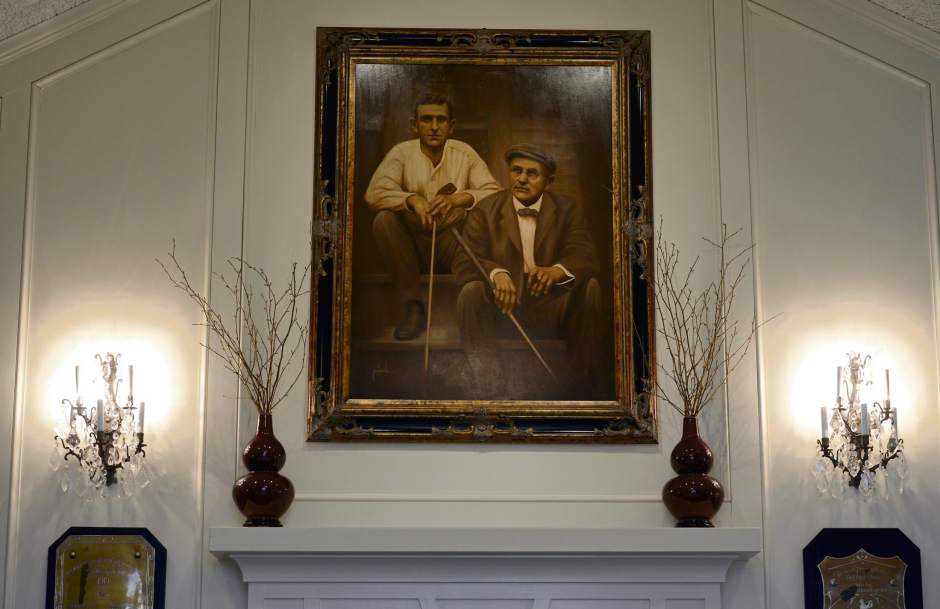Artist re-creates scene
After a long separation, Oakmont Country Club has reunited founder Henry C. Fownes and his son William C. Fownes Jr.
Henry founded the club and built the original course, which opened on Oct. 1, 1904.
William, who later redesigned parts of the course, won the U.S. Amateur Championship in 1910 and was captain of the U.S. team for the first Walker Cup in 1922. He served as the president of the U.S. Golf Association in 1926 and 1927.
For years, a portrait of Henry hung above the fireplace in the clubhouse's Fownes Room. A portrait of William greeted visitors as they entered the building.
In 2014, the Oakmont Country Club restoration committee decided to bring father and son together as part of its two-year project to renovate the clubhouse for the U.S. Open.
A portrait of father and son by artist Tom Pinch now hangs above the fireplace in the Fownes Room.
“We wanted to have both of them pictured together because of their separate contributions to the course and to show them as contemporaries,” said Gerard Hickel, committee chairman.
Only one small image in the club's archives included both men — a 1903 sepia-toned photo of Henry and William sitting on the club steps with four other golfers, each clasping a golf club.
In the photo, Henry is front and center, wearing a tweed jacket and clutching one of his signature cigars. Just behind him and to the right sits William, wearing one of the casual, collarless linen shirts of the period.
“It was the way they looked when the club and course were designed,” Hickel said.
But something larger was needed if it was to be the focal point of the Fownes Room.
Paul Mroz, club manager, suggested the committee contact Pinch, a Los Angeles portrait painter.
On the golf side of his career, Pinch's background includes 20 years as general manager and project director for the Southern California Golf Association.
As an artist, Pinch's works have included photorealistic portraits of prominent personalities, such as Koch Industries CEO and president Charles Koch and former first lady Nancy Reagan.
The sports world is represented by paintings of U.S. Open Golf champions Payne Stewart and Tiger Woods, part of the permanent collection of the United States Golf Association Museum in New Jersey, and a portrait of Kobe Bryant commissioned by the Los Angeles Lakers Association.
Some paintings go into private collections; others hang in museums, corporate offices and country clubs around the world.
His works are done in oil on fiber-wood panels.
“Wood lasts longer than canvas,” Pinch said. “When it dries, it is not susceptible to cracking. The material is so good it has an archival (life) of over 8,000 years.”
Pinch prefers to work with oil because it takes a long time to dry, allowing him to make adjustments throughout an eight-hour work session.
“It allows you to create soft edges,” Pinch said, explaining that blending between the background and subject creates a nice flow.
Like most of Pinch's work, the Fownes portrait was created from a photo. That old photo from the Oakmont archives presented some challenges. Photos from the early 20th-century lack the sharply focused details of contemporary photos.
As Pinch worked, questions arose in a flurry of emails: Was Henry Fownes wearing glasses? Were the club shafts metal or wood? What was Henry holding between his fingers?
“The goal is to somehow pull out at least as much personality as is in the photo,” Pinch said. “You are trying to create the illusion of 3-D on a flat surface. ... It needs to look as good close up as from far away.”
Once the client has approved the computerized image, the process of putting paint on board can begin.
Pinch estimates the Fownes painting took between 20 and 30 hours.
“There was a lot to cover, a lot of fingers, more than one subject and a lot of square inches, especially when the painting needed to be more photorealistic,” he said.
Hickel is pleased with the finished portrait.
“We've gotten a lot of positive reaction,” Hickel said. “Members love the concept that they are both up there, father and son.”
Alice T. Carter is a Tribune-Review contributing writer.

